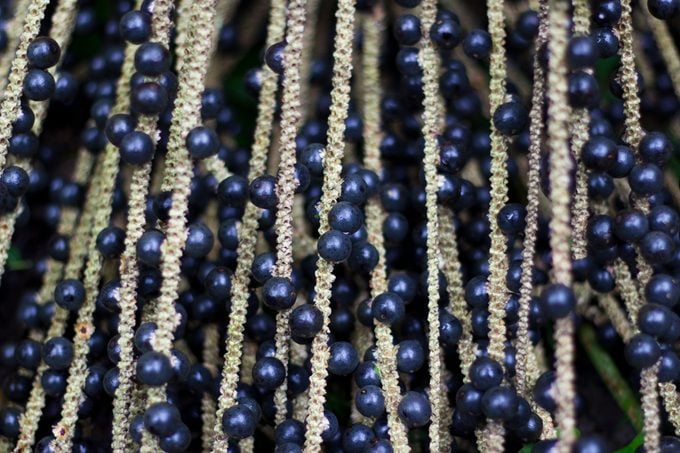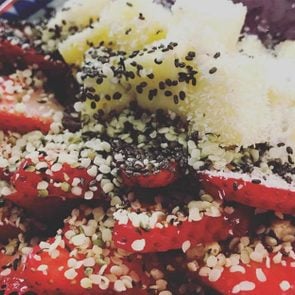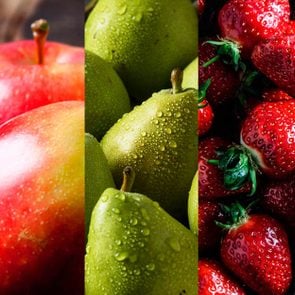Should You Eat Acai Berries? Here Are the Health Benefits
Updated: May 19, 2021
Acai berry benefits range from protecting the heart to supporting brain health. Here's what you need to know about this deep purple superfruit.
Acai berries: The Brazilian “superfruit”
Acai berries are known for their striking deep purple hue. Their mild, not-sweet-at-all taste make them the perfect base for smoothie bowls topped with oats, coconut shavings, and other antioxidant-rich berries. The Brazilian “superfruit” is only increasing in popularity—not just in the U.S., but throughout the world—thanks to its considerable health benefits.
Here’s everything you need to know about the nutrient-dense fruit, including acai berry benefits, nutrition facts, risks, and acai berry recipes.
Where do acai berries grow?
The berry with a funny name (pronounced ah-sah-EE) grows on palm trees in tropical Central and South America, according to the National Center for Complementary and Integrative Health (NCCIH). A longtime diet staple among indigenous people in the Amazon region, the acai has become something of an “it” food in the U.S.
“Because the fruit contains a pit, it is technically a drupe—a fleshy fruit with thin skin and a central stone containing a seed,” says nutritional psychiatrist Umadevi Naidoo, MD, the director of nutritional and lifestyle psychiatry at Massachusetts General Hospital and author of This is Your Brain on Food. Peaches, plums, olives, and cherries are all drupes.
For safe consumption, the outer skin of an acai berry is first soaked to soften it and then mashed to make a paste.
You won’t find fresh acai berries in the produce section of your local grocery store. “The ‘berries’ are fragile and don’t last, so they are frequently exported as frozen fruit puree, powder, or juice,” says Dr. Naidoo. (Here’s what you need to know about chicha morada, a purple corn drink from the Andes.)
Acai berry nutrition facts
According to Sambazon, a certified organic and fair trade acai company, a 100-gram serving of pure unsweetened acai puree contains the following:
Calories: 70
Fat: 5 g (6% DV)
Fiber: 3 g (11% DV)
Protein: 1 g
Carbs: 4 g (1% DV)
Calcium: 23 mg (2% DV)
Potassium: 121 mg (2% DV)
Vitamin A: 26 mcg (2% DV)

Are acai berries good for you?
The short answer is: Yes. Acai’s rich, purple hue is a sign that it contains anthocyanins, antioxidant compounds that may help protect against various diseases.
“Acai is rich in antioxidants, having [several times] the amount found in blueberries,” Dr. Naidoo says. The fruit also beats out cranberries, blackberries, and goji berries.
“What’s interesting about antioxidants is that not only do they help prevent free radical damage from pollution and other everyday stressors, they can also prevent free radicals from doing damage to DNA, which is what leads to cancer and causes aging,” says Emmaline Rasmussen, RDN, a registered dietitian nutritionist in Chicago.
Acai alone won’t prevent health problems—it’s only one fruit—but it can be part of a diet that keeps your cells healthy.
Potential health benefits of acai berries
Protects against heart disease and diabetes
Anthocyanins are antioxidant compounds responsible for the red, purple, and blue pigments in fruits and veggies like berries, currants, red cabbage, and grapes. Research, including a review of studies published in 2017 in Food & Nutrition Research, suggests these antioxidants may help prevent cardiovascular disease, diabetes, and cancer.
The plant compounds in acai have also been shown to improve the production of nitric oxide, a molecule that helps blood vessels dilate and improve circulation, according to a study published in 2016 in Journal of Cardiovascular Pharmacology.
May help weight loss
While acai can fit into a weight loss plan, there is no research to substantiate claims that acai alone promotes rapid weight loss, according to the NCCIH. In fact, the Federal Trade Commission has flagged many acai supplements for deceptive marketing. Be wary of any supplement or powder making weight-loss claims.
On the upside, acai contains zero grams of sugar, which is remarkable for a fruit, says Rasmussen. That means that if you’re on a low-carb diet, acai is a good way to include fruit in your diet. To sweeten things up, add a sugar-free sweetener, like monk fruit or stevia, says Rasmussen. (Try these natural sweeteners and sugar substitutes.)
Even if you’re on a keto diet, you can still fit acai into your meal plan, as it contains just one gram of net carbs, which allows you to get in much-needed fiber. (To figure out net carbs subtract the grams of fiber from the total carbs.)
One warning: Due to its lack of natural sweetness acai products can contain added sugar or are blended with fruit juices. For instance, Sambazon’s “Original” acai blend provides just 100 calories, but it also has 12 grams of added sugars (equal to three teaspoons).
Likewise, acai bowls are often loaded with higher calorie and sweet toppings like honey or granola. A fully loaded bowl could reach upwards of 800 or 900 calories, Rasmussen notes.
May support brain health
Need a brainpower pick-me-up? Start eating acai. “The antioxidants in acai counteract the damaging effects of inflammation and oxidation in brain cells, which can negatively affect memory and learning,” Dr. Naidoo says. (These are the worst foods for your brain.)
Risks of eating acai berries
Frozen, blended acai are safe to eat, says the NCCIH. However, if you are scheduled to get an MRI or are pregnant or nursing, talk to your doctor about whether acai is appropriate for you.
If you are planning on taking acai supplements, choose a reputable, high-quality brand. And discuss potential drug interactions with your doctor and whether a supplement is the best way to achieve your health goals.
Great ways to eat acai and quick recipes to try
Here are some delicious ways to eat acai:
- Add acai powder to baked goods, Dr. Naidoo suggests.
- Mix a packet or half packet into a smoothie with other fruits. Rasmussen particularly likes the taste of acai with frozen blueberries and bananas, along with a half scoop of protein powder. (Too much protein powder can taste chalky with acai, she explains.) Try this Simple Blueberry Acai Smoothie from Mindful Avocado.
- Stir acai powder into plain dairy or non-dairy yogurt, Dr. Naidoo says.
- Make an acai bowl by pouring a blended frozen packet into a bowl and topping with crushed walnuts, chia seeds, and sliced strawberries.
How much acai should you eat?
There is no recommended amount of acai. But many recipes for acai bowls or smoothies call for two packs of frozen, blended acai. It can be an expensive ingredient, so Rasmussen recommends using one pack only to stretch it further. What matters is that you enjoy eating it.
Next, check out these easy recipes for an antioxidant-packed raspberry-beet smoothie and banana chocolate smoothie.
























